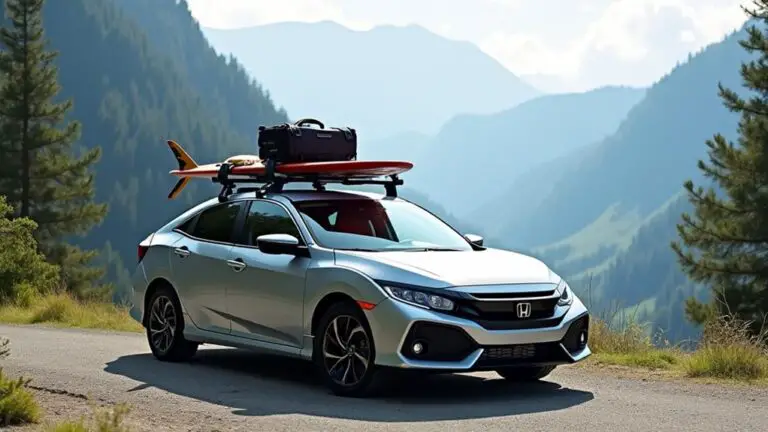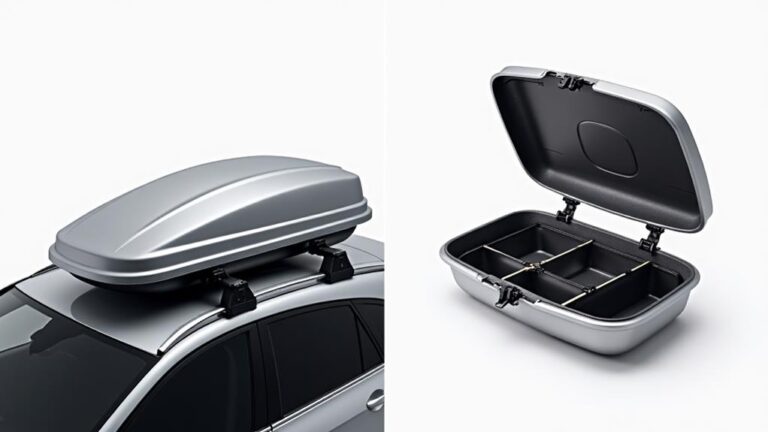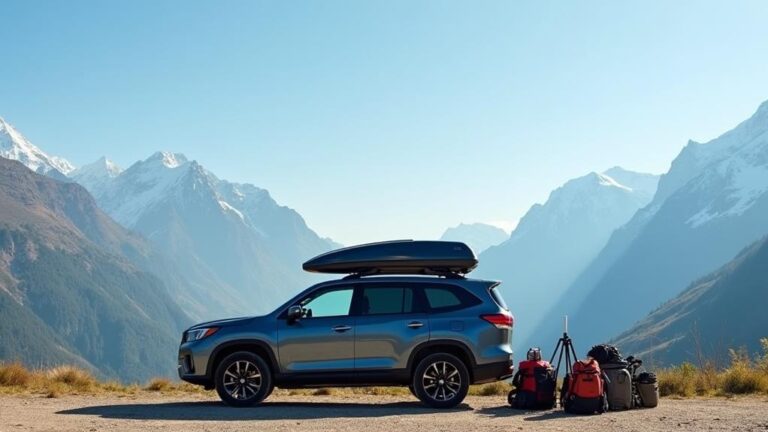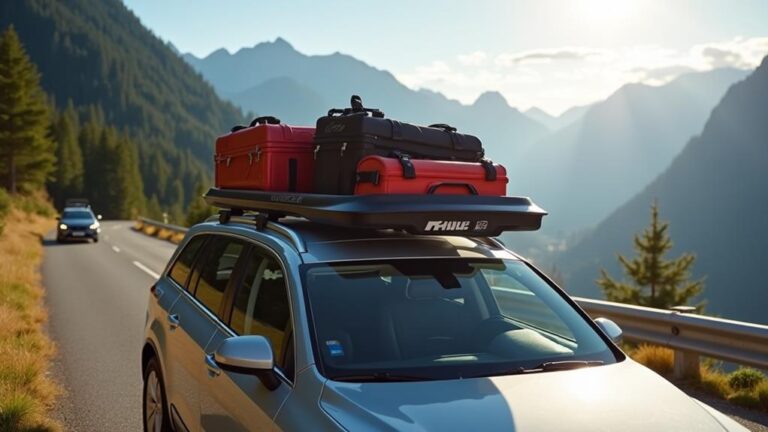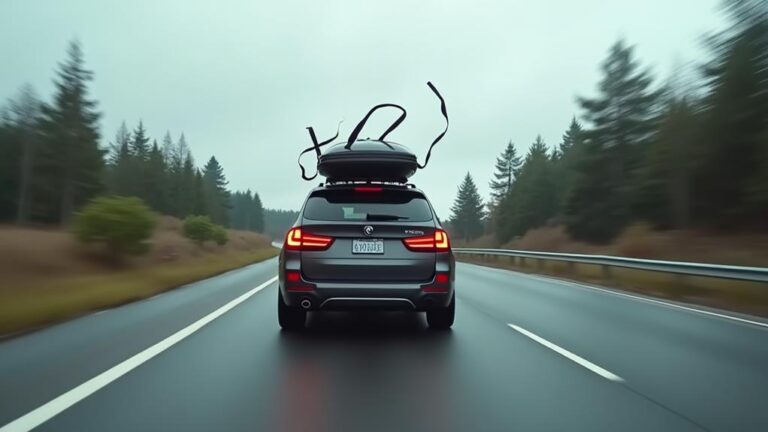You might not know that the speed at which you can safely drive with a cargo box on your vehicle is not fixed, but rather depends on various factors. The type of vehicle, cargo box size and weight, road conditions, and weather all play a vital role in determining the maximum safe speed. If you're planning a road trip with a cargo box, understanding these factors is essential to guarantee your safety on the road. But what specific considerations should you keep in mind, and how can you balance speed with safety? The answer may surprise you, especially when driving in challenging conditions.
Key Takeaways
- Cargo box speed limits vary by state, country, and type of cargo being transported, impacting maximum driving speeds.
- Vehicle type and cargo box compatibility, including size, weight, and roof rack system, affect safe driving speeds.
- Weight and aerodynamics of the cargo box impact vehicle stability, handling, and fuel efficiency, influencing driving speeds.
- Manufacturer's speed recommendations and guidelines, as well as road conditions and weather, must be considered when driving with a cargo box.
- Speeds must be adjusted accordingly to ensure safe transportation of cargo, compliance with regulations, and prevention of accidents.
Factors Affecting Cargo Box Speed
When driving with a cargo box, you'll need to weigh several factors that can impact your speed. One vital consideration is cargo regulations, which vary by state and country. Familiarize yourself with local laws regarding maximum speed limits for vehicles carrying cargo boxes to avoid fines and penalties.
You'll also need to think about the weight and size of the cargo box, as well as the type of cargo being transported.
Insurance premiums are another factor to think about, as they may increase with higher speeds or the transport of high-value items. Check your insurance policy to see if there are any speed restrictions or special requirements for transporting cargo.
Additionally, weather conditions, road type, and traffic density can all impact your speed when driving with a cargo box. It's vital to adjust your speed accordingly to guarantee safe transportation of your cargo and compliance with regulations. By understanding these factors, you can make informed decisions about your speed and guarantee a safe and successful trip.
Vehicle Type and Cargo Box
When choosing a cargo box for your vehicle, you'll need to ponder the type of vehicle you have, as well as the dimensions and weight of the box.
SUVs and trucks often have more compatibility options for cargo boxes due to their roof rack systems and larger size.
You'll want to select a box that matches your vehicle's weight capacity and roof size to guarantee safe and secure transport of your gear.
SUV and Truck Compatibility
Purchasing a cargo box for your SUV or truck requires consideration of several key factors, not least of which is guaranteeing compatibility between your vehicle type and the cargo box itself.
If you own an SUV or truck, you'll need to ponder a few things when selecting a cargo box.
When it comes to SUVs, you'll want to think about the liftgate operation and how the cargo box will interact with it.
Some cargo boxes may obstruct the liftgate or require special installation to accommodate it.
For trucks, you'll need to ponder the truck bed's interior space and how the cargo box will fit within it.
- Liftgate clearance: Verify the cargo box won't obstruct the liftgate or require special installation to accommodate it.
- Interior space: Ponder the interior space of your truck bed or SUV cargo area and how the cargo box will fit within it.
- Rack system: If your SUV or truck has a rack system, verify the cargo box is compatible with it.
- Weight capacity: Don't forget to check the weight capacity of your vehicle's roof or bed to verify it can support the cargo box.
Box Size and Weight
Most cargo boxes are designed for versatility, but it's essential to select the right size and weight for your vehicle type. A box that's too large or too heavy can compromise your vehicle's stability, handling, and fuel efficiency.
When choosing a cargo box, consider the weight capacity of your vehicle's roof rack or hitch. Verify the box's weight is evenly distributed to prevent any strain on your vehicle's suspension.
The size of the cargo box also plays a pivotal role in your vehicle's aerodynamics. A box that's too large can increase wind resistance, while a box that's too small may not provide enough storage space.
Consider your vehicle customization needs and choose a box that complements your vehicle's design. It's also essential to check your cargo insurance policy to verify it covers your vehicle and cargo box combination.
When selecting a cargo box, look for one that's specifically designed for your vehicle type. Many manufacturers offer cargo boxes with weight capacities and sizes tailored to specific vehicles. By choosing the right size and weight, you can guarantee a safe and efficient driving experience.
Weight and Aerodynamics Impact
As you hit the road with a cargo box, vital to take into account how its weight and aerodynamics affect your vehicle's overall performance.
The added weight of the cargo box can alter your vehicle's center of gravity, impacting its stability and handling.
Proper cargo balance is essential to maintain your vehicle's aerodynamics and overall performance.
- Cargo balance: Verify that your cargo is evenly distributed within the box to maintain a low center of gravity. This will help prevent your vehicle from swaying or tilting, which can affect its aerodynamics.
- Aerodynamic modifications: Consider investing in aerodynamic modifications such as a rear spoiler or side skirts to reduce drag and improve your vehicle's overall aerodynamics.
- Air resistance: The cargo box's shape and size can increase air resistance, affecting your vehicle's speed and fuel efficiency. A sleeker box design can help reduce air resistance.
- Downforce: A cargo box can also create downforce, which can improve your vehicle's stability at high speeds. However, excessive downforce can lead to reduced fuel efficiency and increased drag.
Manufacturer's Speed Recommendations
Typically, a cargo box manufacturer provides speed recommendations to guarantee safe and efficient operation of their product. These recommendations are based on extensive speed testing, which takes into account various factors such as box design, size, and weight capacity.
The manufacturer's speed testing process involves simulating real-world driving conditions to identify the maximum speed at which the cargo box can be safely used.
When reviewing the manufacturer's speed recommendations, you should consider the specific design features of the cargo box. For example, a box with a sleek, aerodynamic design may be suitable for higher speeds, while a larger box with a more boxy design may require lower speeds.
Additionally, some manufacturers may provide speed recommendations based on the type of cargo being carried, such as fragile items or heavy loads.
It is essential to follow the manufacturer's speed recommendations to guarantee safe and efficient operation of the cargo box. Exceeding the recommended speed can compromise the stability and security of the box, potentially leading to damage or loss of cargo.
Road Conditions and Weather
Driving on various road conditions and in different weather conditions can noticeably impact the performance and stability of your cargo box.
As you drive with a cargo box, you'll need to adjust your speed accordingly to guarantee a safe and smooth ride.
When driving in challenging conditions, it's crucial to take into account the following factors:
- Night driving: Reduce your speed when driving at night, as visibility is limited and it's more challenging to anticipate obstacles.
- Mountain terrain: Slow down when driving uphill or downhill, as steep inclines and declines can affect your vehicle's traction and stability.
- Wet or icy roads: Decrease your speed to account for reduced traction and increased stopping distance.
- Wind or stormy weather: Reduce your speed to maintain control and stability in strong winds or heavy rain.
Towing and Cargo Box Combinations
When towing a trailer with a cargo box, you'll need to ponder the towing vehicle's capacity and the weight limits of the cargo box.
Your vehicle's Gross Trailer Weight Rating (GTW) is the maximum weight it can safely tow, while the cargo box's weight limit is the maximum weight it can carry.
Towing Vehicle Capacity
To guarantee safe towing, consider the following factors:
- Gross Vehicle Weight Rating (GVWR): The maximum weight of your vehicle, including passengers, cargo, and towing capacity.
- Gross Trailer Weight Rating (GTW): The maximum weight of the trailer, including the cargo box and its contents.
- Tongue Weight: The weight of the trailer that's applied to the towing vehicle's hitch.
- Cargo Capacity: The weight of the cargo box and its contents, which must be within the towing vehicle's towing limitations.
When combining a towing setup with a cargo box, make certain to stay within the towing vehicle's capacity to avoid exceeding the towing limitations and compromising the cargo capacity.
Cargo Box Weight Limits
Cargo boxes mounted on vehicles can substantially impact towing capacity, and it's essential to take into account the weight limits of both the towing vehicle and the cargo box.
The weight of the cargo box itself, along with its maximum payload capacity, must be considered when determining your vehicle's overall towing capacity. Check your vehicle's owner's manual or manufacturer's website to find the maximum towing capacity and cargo box weight limits.
When combining towing and cargo box capacities, verify that you don't exceed the maximum weight limits of either the vehicle or the cargo box.
Proper cargo distribution is fundamental to maintain load balancing and prevent uneven weight distribution. Overloading can lead to reduced vehicle stability, increased stopping distance, and a higher risk of accidents.
It's essential to think about the weight of the cargo, the cargo box, and the towing vehicle when calculating the total weight. Always follow the manufacturer's recommendations for cargo box weight limits and towing capacity to guarantee safe and stable transportation of your cargo.
Safety Considerations and Precautions
How safely you drive with a cargo box installed on your vehicle largely depends on your adherence to safety considerations and precautions.
You must guarantee that the cargo box is properly installed and secured to prevent it from shifting or detaching while driving.
Additionally, you should also consider the weight and size of the cargo box, as well as the type of cargo being transported.
To minimize the risks associated with driving with a cargo box, you should:
- Monitor your speed: Adjust your speed according to road conditions and weather to prevent loss of control or cargo shifting.
- Avoid driver fatigue: Take regular breaks to rest and stretch to prevent fatigue, especially on long trips.
- Check your cargo insurance: Certify you have adequate coverage for your cargo in case of accidents or damage.
- Regularly inspect your cargo box: Check for damage or wear and tear to guarantee it remains safe and secure.
Frequently Asked Questions
Can I Install a Cargo Box on Any Vehicle Type?
You can install a cargo box on various vehicle types, but first, you must check the load capacity and vehicle compatibility, considering factors like roof size, weight limits, and attachment system requirements.
Do Cargo Boxes Affect Vehicle Insurance Rates?
You think a cargo box is just a harmless upgrade, but beware, it might just become a pricey accessory – check with your insurer, as some offer insurance discounts with cargo coverage, others don't.
Are Cargo Boxes Allowed on All Highways and Roads?
You should check road signs and local regulations before driving with a cargo box, as some toll roads and restricted highways may prohibit or have specific requirements for vehicles with cargo carriers or roof boxes.
Can I Use a Cargo Box for Oversized Items?
About 70% of Americans use their vehicles for moving gear. When using a cargo box for oversized items, you'll need to reflect on the cargo weight and verify you're within oversized limits, usually 6-8 feet long and 3-4 feet wide.
Do Cargo Boxes Void Vehicle Warranties?
You should review your vehicle's warranty clauses, as manufacturer liability may be affected by aftermarket additions, including cargo boxes, which could void your warranty if not installed or used according to manufacturer specifications.
Conclusion
Don't even think about pushing your vehicle to the limit with a cargo box – your safety's at stake. You'll be tempting fate by driving like a maniac with a box on top that's a potential sail in the wind. Keep it real, and you'll live to drive another day. Stick to the recommended 65-80 mph, and adjust according to road conditions and weather. Your life's worth more than a few minutes shaved off your trip.


